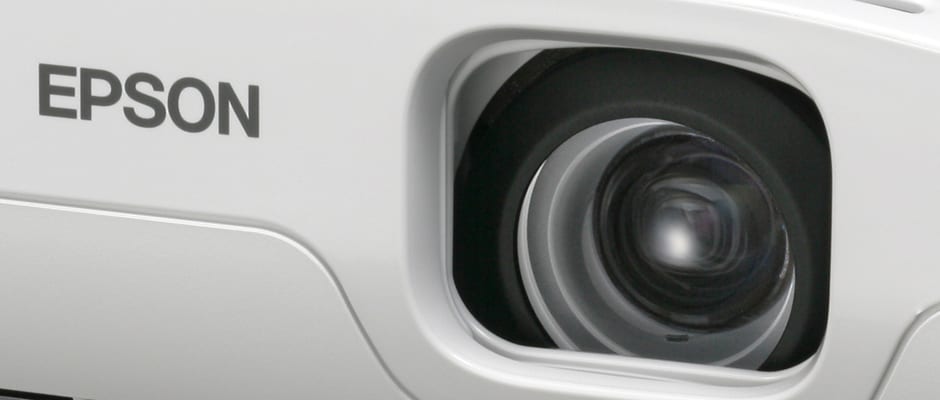Pros
Cons
Introduction
Front
The Epson PowerLite Home Cinema 705HD is a small, compact LCD projector that has a clean, simple design. It also comes with a carrying case.
{{section_header}}{{section.name}}{{/section_header}}
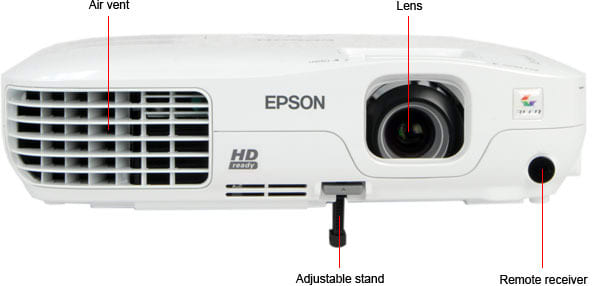
Back
{{section_header}}{{section.name}}{{/section_header}}
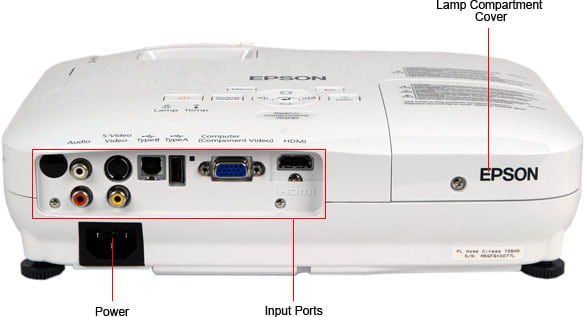
Sides
{{section_header}}{{section.name}}{{/section_header}}
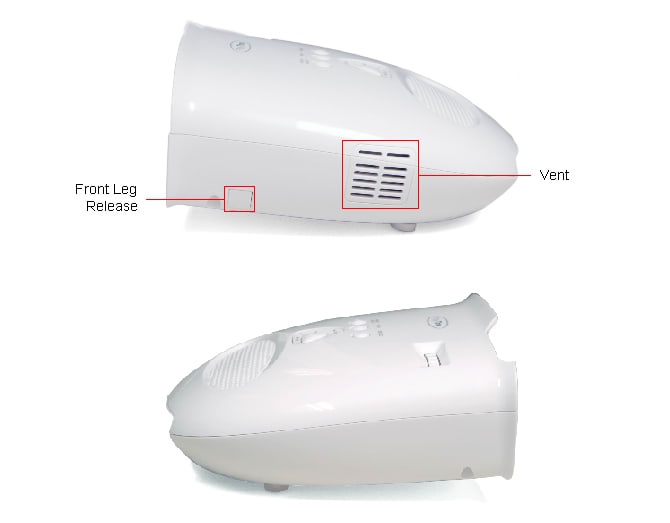
Top/Bottom
{{section_header}}{{section.name}}{{/section_header}}
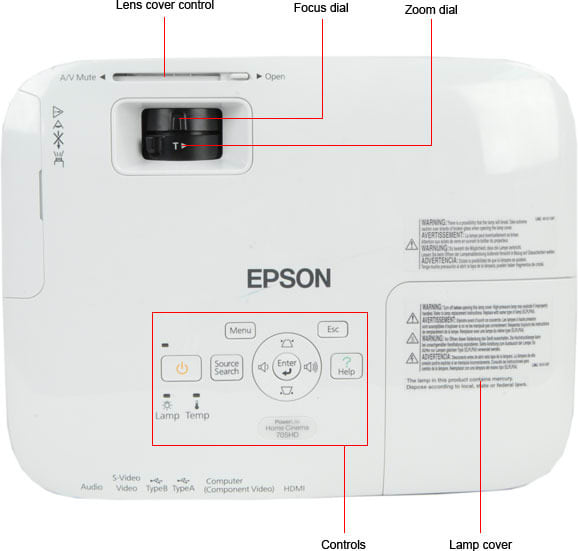
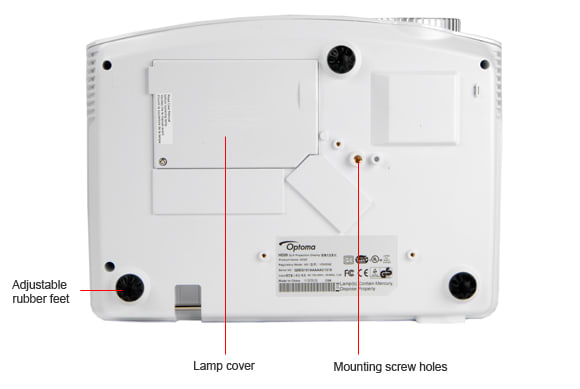
Stand/Mount
{{section_header}}{{section.name}}{{/section_header}}
The stand of the 705HD allows for adjustment of the viewing angle by both raising and lowering the front and back of the projector body. It also has standard VESA mounting screws on the bottom which allow for wall or ceiling mounting. No wall/ceiling mount is included.
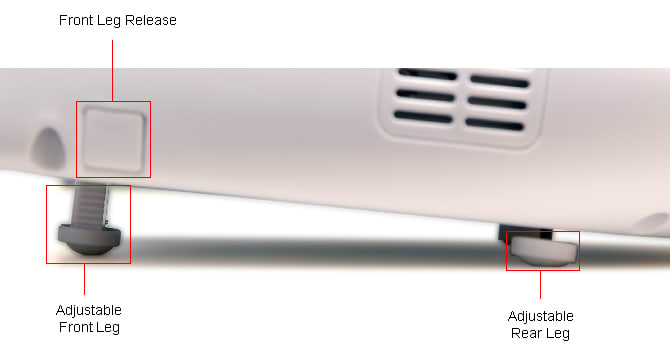
Lamp
Remote Control Tour
{{section_header}}{{section.name}}{{/section_header}}
The small remote control that comes with the projector allows for full control of the projector, but cannot control other devices
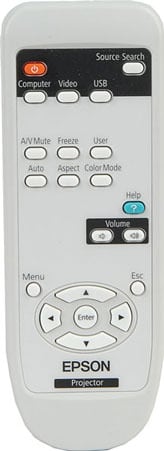
The small remote control of the 705HD
In the Box
{{section_header}}{{section.name}}{{/section_header}}
As well as the projector, you get:
*carrying case
*quickstart manuals
*power cable
*Component to VGA adapter
*CD-ROM that includes the full manual as a PDF
Not included are any video or audio cables, which is a bit annoying.
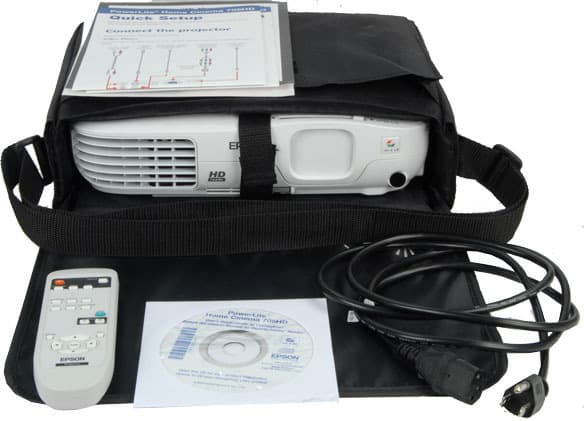
The 705HD comes with a carrying case, manuals, power cable and remote
Portability
{{section_header}}{{section.name}}{{/section_header}}
The 705HD is very portable: we weighed the combination of the projector, cables and carrying case at 5.5lbs, and it is a pretty small and compact combination.
{{product.raw_scores['Portability']}}
Setup Assistance
{{section_header}}{{section.name}}{{/section_header}}
The 705HD is a simple projector to set up: plug in, connect the source, power on, select source and you are off. The Auto Keystone feature uses a level in the projector to set the adjustment for the projection angle, and we found that this did an effective job. This can be overridden if required, though, and the keystone can be adjusted to 30 degrees either up or down.
{{product.raw_scores['Setup']}}
Aesthetics
{{section_header}}{{section.name}}{{/section_header}}
The 705HD has a clean, straightforward look that is more about functionality than aesthetics. But the shiny white case would certainly not look out of place in a modern office filled with shiny laptops and white walls.
Peak Brightness
{{section_header}}{{section.name}}{{/section_header}}
We found in our tests that the 705HD was capable of producing a decent amount of light: in the Dynamic mode, we measured the white screen output at 2304 lumens, just a touch below the rated 2400 lumens. In the Living Room and Theater modes, we found that the output was somewhat lower, at 2083 and 1636 lumens respectively.
On our 80-inch test screen, we found that this light output in the Dynamic mode translated into a screen brightness of 197 Cd/m2, which is equivalent to a bright standard HDTV.
Tunnel Contrast
{{section_header}}{{section.name}}{{/section_header}}
The brightness of the whites that a projector produces are only part of the story: it also has to produce the deep blacks that give an image dramatic impact. Some projectors have issues here: the whites in an image bleed into the blacks, producing muddy grays. We found a little bit of this with the 705HD because when we measured the level of a black area of the screen as it was surrounded by more and more white, we found that it increased significantly. This means that high contrast screens might lack impact because the blacks would be brighter than they should be.
Uniformity
{{section_header}}{{section.name}}{{/section_header}}
We also found that the 705HD produced a clean, uniform image without any major issues, in both bright and dark scenes. In the chart below, we show the lux value measured at 9 different locations on the screen, with the projector located on a table at the same height as the bottom of the screen. Although the lux value varies a lot across the screen, the pattern is uniform and there are no sudden changes or variations.
Below are photos of both black and white screens, and you can see that there are no significant problems with brighter or darker patches on the screen.
Greyscale Gamma
{{section_header}}{{section.name}}{{/section_header}}
We measured the greyscale gamma (the slope of the curve that shows how quickly the projector goes from black to white) to be about 2.05, which is just below the ideal 2.1 to 2.2 range that we look for. But that's a very acceptable result.
Color Temperature
{{section_header}}{{section.name}}{{/section_header}}
Our first color test looks at the consistency of the color temperature of whites as their intensity decreases. A perfect projector would keep the same color temperature as the intensity increased, but the 705HD was not perfect: we saw a number of distinct shifts in the color temperature, especially at the lower intensities. What this means is that some greys on the screen may have a slight orange look to them.
Color Temperature
RGB Curves
{{section_header}}{{section.name}}{{/section_header}}
In this test, we analyze the color response curve for the red, green and blue primary colors. On a perfect display, this curve would be completely smooth, meaning that the projector can accurately reproduce subtle color changes that are in the original image. The 705HD didn't have a very smooth response: all of the curves have lots of stair-steps, which are where the projector didn't accurately reproduce a subtle change in the color on the screen. Below the graph, you can see color gradients, with the top one being the ideal gradient, and the bottom being what the 705HD produced. Here, you can see what the sudden jumps on the graph mean: bands in the gradient that are not present in the original.
Color Gamut
{{section_header}}{{section.name}}{{/section_header}}
We found that the 705HD didn't quite stick to the color limits for HD broadcast colors. These limits (called the color gamut) are set in a standard called Rec.709, which defines what colors are present in an HD signal, so a perfect display would exactly match these. The 705HD did a rather lackluster job here: the red corner of the gamut is significantly off, and the other corners are somewhat shifted. What this means is that some colors (particular very deep ones) will look a little different to what the filmmaker intended.
Motion Smoothness
{{section_header}}{{section.name}}{{/section_header}}
The Epson 705HD does not seem to do any motion processing: it simply displays whatever video frames the device sends it without processing. That is evident on our test image below: shot at 1/60th of a second, you can see just a single frame of the video, indicating that the projector is not inserting other processed frames or doing other tricks to smooth the motion on the screen.
Motion Artifacting
{{section_header}}{{section.name}}{{/section_header}}
Because the 705HD does not do any video processing, we saw little evidence of any major artifacts in the video, with motion looking smooth and natural. And because this projector uses 3 separate LCDs to create the image, we also saw none of the rainbow effect that often bedevils DLP projectors.
3:2 Pulldown & 24fps
{{section_header}}{{section.name}}{{/section_header}}
This projector does not support 3:2 pulldown processing, (often called inverse telecine), which is used by some broadcasters to give their TV shows a more film-like look. Neither does it support a 24 frames a second signal: if you feed it a 24fps signal from a device such as a Blu-ray player, it will not display it.
Resolution Scaling
{{section_header}}{{section.name}}{{/section_header}}
The 705HD is a WXGA projector, which means it has a resolution of 1280 by 800 pixels. The closest video resolution to this is 720p, but it can also cope with video signals at other resolutions. To test this, we look at a series of test screens at different resolutions. We found that the best results were obtained by providing the projector with a 720p signal, which is closest to the native resolution of the projector.
480p
The Projector scales 480p video to fit into the entire height of the screen. It does a clean job of this, but the image does look somewhat soft. This is not unexpected, though; the projector is stretching a 480 pixel high image to fit.
720p
720p video is the closest to the native resolution of the projector, and it does a very effective job of displaying this, letterboxing the top and bottom of the screen so every pixel of the image is displayed.
1080i & 1080p
Although it is only a 720p projector, the 720p can cope with a higher resolution signal. However, 1080i or 1080p images are down-scaled to fit the same letterboxed size as the 720p images, so the images on screen look somewhat fuzzy and fine details are lost.
3D Readiness
{{section_header}}{{section.name}}{{/section_header}}
The Home Cinema 705HD does not include any support for displaying 3D content.
Throw
{{section_header}}{{section.name}}{{/section_header}}
All projectors have a distance (or range of distances) across which they can project (or "throw") an image. This is important as it determines where the projector has to be mounted. If a projector has a small throw distance, it can be located close to the screen. If it has a long throw distance, it can be placed far back, away from the screen. Some projector (like the 705HD) also include a zoom lens which allows you to adjust the throw angle, and this makes the projector more flexible. To project onto a 64-inch screen (measured diagonally), the 705HD has to be placed between 6 foot 7 inches and 7 foot 9 inches away.
Screen Brightness
{{section_header}}{{section.name}}{{/section_header}}
The bigger the screen, the less bright the image that the projector produces. In the table below, we calculated how bright the image would be for a number of different sizes, and if this would be usable in a number of different lighting situations.
We found that the 705HD produces an image which would still be usable up to about 120 inches in a darkened room (such as your living room at night), but would only be usable in a typical office to a size of about 64 inches: anything bigger than this, the image becomes almost unrecognizable, as it is not visible.
To show how the image would look in a number of different lighting levels, we project a test image onto our test screen (which is 80 inches on the diagonal) and adjust the light levels. As you can see below, the image becomes rather pale and unattractive at the higher light levels, so this proejctor would do a poor job in a moderate and well-lit room: it simply can't produce enough light to still be visible with moderate ambient light.
Screen Materials
{{section_header}}{{section.name}}{{/section_header}}
You don't always have a projection screen handy: sometimes, you have to project onto whatever is on the walls. Below, you can see photos of the images that this projector produced when shining onto a number of materials: a white-painted wall, a cream painted wall, wood paneling and a glossy whiteboard screen. The 705HD doesn't have many options to compensate for different materials or colors, apart from a color tint control that can be used to tweak the color to some degree. Other projectors offer a number of presets for different paint colors, but the 705HD does not.
Optical Issues
{{section_header}}{{section.name}}{{/section_header}}
We use a number of test screens to examine the optical performance of projectors, but we found very few issues with the 705HD: it produced a very clean, sharp image across our test screen. The top image is the original test screen that we are projecting, with the crops below showing how the proejctor reproduces the image. As you can see, the result is a sharp, clean image with little or no distortion or other issues.
Video Processing
{{section_header}}{{section.name}}{{/section_header}}
The 705HD includes a few video processing features. However, we found that most didn't have any significant effect on image quality.
Formats
{{section_header}}{{section.name}}{{/section_header}}
The 705HD is a WXGA projector, with a native resolution of 1280 by 800 pixels. The cloest video equivalent to that is 720p, with a resolution of 1280 by 720.
Calibration
{{section_header}}{{section.name}}{{/section_header}}
There is no one video mode or group of settings that is good for all of the situations that a video projector can be used in. So, we pick one: watching movies in a darkened room. The settings below are our recommended starting points for this, and the settings that we use in our color tests. Feel free to use these as a starting point for your own personal calibration, but remember that the best calibration is the one that produces the best image quality for your own situation.
Our calibrated settings for movie watching involved some tweaks to reduce the brightness and increase the contrast of the projector, as well as disabling the auto iris. We found that these settings produced the best balance of color accuracy and screen brightness: pushing the contrast in particular any further caused a lot of peaking, where highlight details get lost.
Video Modes
{{section_header}}{{section.name}}{{/section_header}}
The 705HD includes a range of preset video modes.
Ergonomics & Durability
{{section_header}}{{section.name}}{{/section_header}}
The small remote that comes with this projector feels somewhat plasticky and fragile: we doubt that it would stand up to rough treatment.
Button Layout & Use
{{section_header}}{{section.name}}{{/section_header}}
The layout of the buttons on the remote is pretty good, putting the most commonly used buttons at the top of the remove where they fall comfortably under the thumb. Epson wisely also provided dedicated buttons for the most commonly used features, such as the source search on the top right, which sets the projector to search all of the video inputs. There is also a user button, which can be customized to control a number of features from the on-screen menu.
The remote also allows for direct access to the on-screen menu with the menu button, and a 4-way d-pad and enter buttons make it easy to move around. That is very useful if the projector is mounted on the roof or in another unusual position: you can control the projector from the remote in exactly the same way you do on the controls themselves.
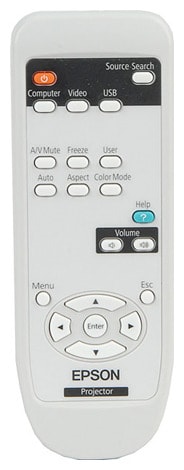
Programming & Flexibility
{{section_header}}{{section.name}}{{/section_header}}
This remote cannot control any devices other than the Epson projector it comes with: there is no way to program it to control other devices. That is not unusual, though; most proejctor remotes are basic devices, as serious home theater users will replace them with programmable ones.
Input Ports
{{section_header}}{{section.name}}{{/section_header}}
The input ports for this projector are grouped on the back of the body. There are a rather minimal number: one HDMI, one S-Video and one composite video. Alongside the composite video are two inputs for analog stereo audio to drive the small built-in speaker. Not present are any component video inputs, or any DVI ports. To drive this projector from a computer with a DVI port, you'll need to add a DVI to HDMI converter. Fortunately, these only cost a few dollars.
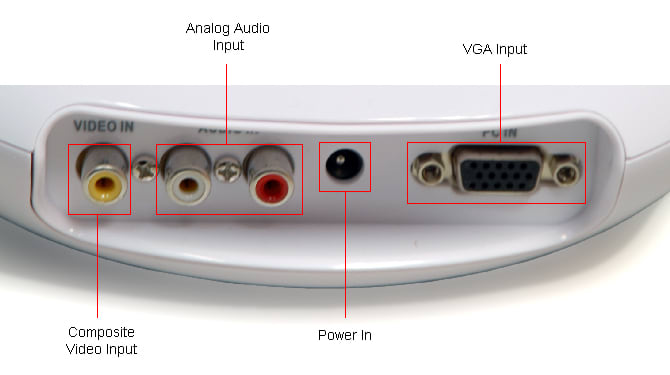
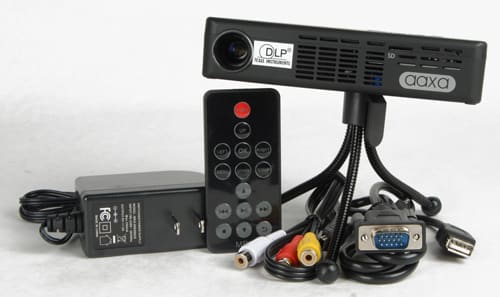
Lots of cables are included
Other Connections
{{section_header}}{{section.name}}{{/section_header}}
Two USB ports are present: one for connecting devices such as USB thumb drives or digital cameras (the type A one) and one that allows the proejctor to be serviced and calibrated from a PC. If you plug a USB thumb drive or digital camera into the first port and press the USB button on the remote, the projector will try and display the images it finds on the device as a slideshow.
Placement
{{section_header}}{{section.name}}{{/section_header}}
The ports are well located for everyday use, as befits a projector that is likely to be used on the go a lot of the time.
Internet & Media Features
Menus & Manual
{{section_header}}{{section.name}}{{/section_header}}
A basic printed quick-start guide is supplied with the projector, with a fuller manual on the included CD-ROM. Both of these do a decent job of explaining the features of the projector to the user.
The on-screen menu system is similarly basic, but adequate for general use. It divides the options into 6 categories, shown as tabs on the left side: Image, Signal, Settings, Extended, Info and Reset. This structure works well, putting the most commonly required features (such as changing imag
Noise
{{section_header}}{{section.name}}{{/section_header}}
The 705HD is a little on the noisy side: we found that the average noise level around the projector was around 50 decibels. That is somewhat higher than other similarly sized projectors, and it would definitely be very noticeable if this projector was sitting on your conference room table.
{{image_chart title="Noise", attachment="Noise Graph"}}
Heat
{{section_header}}{{section.name}}{{/section_header}}
Like all projectors, we found that the 705HD generates quite a lot of heat. This could be an issue if you are running the projector in an enclosed space, or in an already hot room.
{{image_chart title="Heat", attachment="Heat Graph"}}
Power Consumption
{{section_header}}{{section.name}}{{/section_header}}
The 705HD is a small projector, but it still uses a quite significant amount of power. In our tests, we found that it used about 256 watts of power in the Dynamic mode. If you were to run this projector for 5 hours a day, that means it would cost just over $50 a year to run.
The different color modes that the 705HD offers did not significantly affect the power consumption: it remained the same when running it in Dynamic, Living Room, Theater or Game mode. What did make a big difference was enabling the Eco mode: this reduced the power consumption from around 256 watts down to about 204, which means it would be cheaper to run. It also significantly reduced the brightness of the image, though: see our Blacks & Whites section for more information.
If we translate that into the approximate cost to run the projector (assuming 5 hours a day of use), we find that this projector would cost about %50 to run in the brightest modes, and about $40 with the eco setting enabled.
{{image_chart title="Power Consumption (modes)", attachment="Power Consumption Modes Graph"}}
The 705Hd compares well with other projectors of similar sizes and brightness: we found that it used TK.
{{image_chart title="Power Consumption (calibrated)", attachment="Power Consumption Comparison Graph"}}
Lamp Life
{{section_header}}{{section.name}}{{/section_header}}
Epson claims that the V13H010L54 lamp of the 705HD will last for around TK hours. A new lamp will cost you about $200.
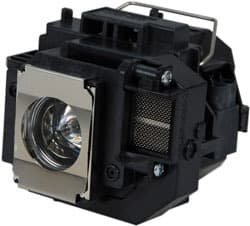
The lamp of the 705HD
Value
{{section_header}}{{section.name}}{{/section_header}}
Both projectors are available for about $700, so the question of value is more about what you prize most: the portability and brightness of the Epson, or the color performance and extra connectivity of the Viewsonic.
Blacks & Whites
{{section_header}}{{section.name}}{{/section_header}}
Both projectors can crank out a lot of light, producing upwards of 2700 lumens in their brightest modes.
{{image_chart title="Contrast", attachment="Contrast Graph"}}
Color
{{section_header}}{{section.name}}{{/section_header}}
The PJD6531w was the top scorer in our color performance tests, doing a better job of rendering fine color changes when properly calibrated than the Epson. You can see this in the color gradients below: the Viewsonic looks smooth, while the Epson has serious banding.
Motion
{{section_header}}{{section.name}}{{/section_header}}
Both projectors did a decent job of rendering smooth motion, but we found that the Viewsonic motion looked a little smoother and more natural. The Viewsonic does share the same rainbow effect issue that most DLP projectors have, where a color fringe can be seen on some fast moving objects.
Viewing Effects
{{section_header}}{{section.name}}{{/section_header}}
Both projectors provide a good amount of flexibility in where they can be placed, and both have the power to fill a good sized screen in a dark or dimly lit room. Neither has the power to cut through a lot of ambient light, though, so they would not work in a well-lit room or would not work adequately on a large screen.
Connectivity
{{section_header}}{{section.name}}{{/section_header}}
Both projectors have the basic connections that are required for everyday use, with HDMI, VGA and analog video inputs. The Viewsonic has the advantage of offering multiple VGA inputs, which could be useful if you are looking to connect multiple devices to a single projector. Both only have one HDMI port, though, so you will need to add a HDMI switch if you want to connect more than one device to either.
Value
{{section_header}}{{section.name}}{{/section_header}}
The Optoma HD66 is available for about $630, a little cheaper than the Epson. The features that the two projectors offer are pretty much comparable, though.
Blacks & Whites
{{section_header}}{{section.name}}{{/section_header}}
The Optoma had the highest brightness of the two projectors, but the Epson was more consistent across the different modes on offer. Although the HD66 had the higher luminance in its appropriately named bright mode, the brightness in the other modes was significantly lower than the comparable modes on the Epson.
{{image_chart title="Contrast", attachment="Contrast Graph"}}
Color
{{section_header}}{{section.name}}{{/section_header}}
Optoma had the clear winner here: we found that the color performance of the HD66 was much better than the 705HD, with much smoother color response that makes for more natural colors and much less banding from subtle color chages (such as a blue sky).
Motion
{{section_header}}{{section.name}}{{/section_header}}
Both projectors produced smooth motion, but we found that the Optoma had a more natural feel to it. Like all DLP projectors, we did see some of the so-called rainbow effect, where some fast moving objects show a series of differently colored fringes as they move, producing a rainbow on the screen.
Viewing Effects
{{section_header}}{{section.name}}{{/section_header}}
The Epson provides more flexibility in placing the projector, as the wider zoom range means it can sit closer or further from the screen as required. The Optoma only has a limited zoom range.
Both projectors can produce a lot of light, but not enough to fill a big screen in a well-lit room. With both, you will need to either dim the lights or get closer to the screen and put up with a smaller image.
Connectivity
{{section_header}}{{section.name}}{{/section_header}}
Both projectors provide a decent range of connections, with HDMI, VGA and a variety of analog audio and video ports. Neither offers multiple HDMI ports, though, so you will have to add a HDMI switch if you want to connect several HDMI devices to either projector.
Value
{{section_header}}{{section.name}}{{/section_header}}
The Epson is the cheaper projector, priced at around $700. The LV-8310 is more expensive, at around $900.
Blacks & Whites
{{section_header}}{{section.name}}{{/section_header}}
The Canon LV-8310 is the brighter projector, which is important for use in well-lit environments. However, the difference between this and the Epson is not huge: both provide clean, bright images.
{{image_chart title="Contrast", attachment="Contrast Graph"}}
Color
{{section_header}}{{section.name}}{{/section_header}}
The LV-8310 was the better performer in our color tests, with more consistent color temperature and smoother color curves. Both of these translate into smoother, more accurate color on the screen.
Motion
{{section_header}}{{section.name}}{{/section_header}}
Neither projector wowed us with smooth motion on the screen. The 705HD can display 120 frames a second, but it does not seem to use this to produce any smoother motion than the Canon.
Viewing Effects
{{section_header}}{{section.name}}{{/section_header}}
Both projectors include 1.2x zoom lenses that provide some flexibility in where the projector can be placed, but we found that the Canon offered a slightly wider range on which it could be placed to fill a particular screen size. We found that the additional lumens that the LV-8310 offers make it more able to cut through incidental lighting, but both projectors are suitable for office use with a small or medium sized screen.
Connectivity
{{section_header}}{{section.name}}{{/section_header}}
Both projectors offer a number of inputs, allowing for both analog and digital video sources to be connected. The Canon projector does not have a HDMI port, though; it offers a single DVI port in its place. The Epson has no DVI port, but you can connect a DVI device with an additional DVI>HDMI adapter that costs less than $10.
Conclusion
The Epson 705HD is a compelling package for the user who needs a powerful projector in a compact package. It has enough light output to illuminate a medium sized screen and is small enough to fit into a carry-on bag. While the fan is somewhat noisy and the color performance was disappointing, the 705HD put up some decent numbers on our other tests. As long as you don't mind a noisy fan, and you value brightness over accuracy, the 705HD is worth its $600 price tag.
Meet the tester
Richard Baguley is a veteran writer who has written about technology ranging from Alphabet to Zip file utilities. He has contributed to pretty much every major tech publication, including Amiga Format Magazine, PC World, Wired, CNET, Toms Guide, Forbes, and many others. He lives in the Boston metro area with his wife, dog, and an indeterminate number of cats.
Checking our work.
Our team is here to help you buy the best stuff and love what you own. Our writers, editors, and experts obsess over the products we cover to make sure you're confident and satisfied. Have a different opinion about something we recommend? Email us and we'll compare notes.
Shoot us an email